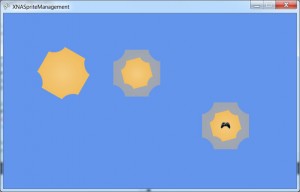My team recently won Best Game Award – 1st Prize at a “make a game in 32 hours” competition, and I thought I’d share the mini engine I wrote during this period to handle sprites.
Features
- Easy to use and extensible inheritance-based object system
- Animated sprite support
- Camera-based sprite batch support
- Automatic update/draw calls with manual overrides
- Late drawing
- Tag system for linking together sprites
- Linear and Rotation velocity
- Rectangle intersection test
Screenshot

License
The license is MIT.
Download
https://github.com/danielsefton/XNA-Sprite-Management
Usage
YourGame.cs:
public class YourGame : Microsoft.Xna.Framework.Game { GraphicsDeviceManager graphics; SpriteBatch spriteBatch; SpriteManager spriteManager; Texture2D spriteTexture, animatedSpriteTexture, playerTexture; public GraphicsDeviceManager Graphics { get { return graphics; } } public YourGame() { graphics = new GraphicsDeviceManager(this); Content.RootDirectory = "Content"; // Add the SpriteManager component. spriteManager = new SpriteManager(this); Components.Add(spriteManager); } protected override void LoadContent() { // Create a new SpriteBatch, which can be used to draw textures. spriteBatch = new SpriteBatch(GraphicsDevice); // Load the textures. spriteTexture = Content.Load<Texture2D>("TestSprite"); animatedSpriteTexture = Content.Load<Texture2D>("TestAnimatedSprite"); playerTexture = Content.Load<Texture2D>("TestPlayerSprite"); // Create a standard sprite, rotated in code. Sprite sprite = spriteManager.CreateSprite("TestSprite", spriteTexture); sprite.Origin = new Vector2(spriteTexture.Width / 2, spriteTexture.Height / 2); sprite.Position = new Vector2(sprite.Origin.X + 100, sprite.Origin.Y + 100); sprite.RotationVelocity = 0.01f; // Create an animated sprite with a 6 frame sprite sheet. Sprite animatedSprite = spriteManager.CreateSprite( new AnimatedSprite("TestAnimatedSprite", animatedSpriteTexture, 6, 6)); animatedSprite.Position = new Vector2(300, 100); // Create a controllable sprite. Notice the inheritance; a nice use of // polymorphism & encapsulation here. Sprite playerSprite = spriteManager.CreateSprite( new PlayerSprite("TestPlayerSprite", playerTexture, 6, 6)); playerSprite.Position = new Vector2(500, 100); // Tags are a method for linking together one or more sprites. // Usage: spriteManager.GetSpriteWithTag("player"); playerSprite.Tag = "player"; } } |
PlayerSprite.cs – Example of custom sprite:
class PlayerSprite : AnimatedSprite { private int speed = 3; // Player speed public PlayerSprite(String name, Texture2D texture, int frameCount, int framesPerSec) : base(name, texture, frameCount, framesPerSec) { } public sealed override void Update(GameTime gameTime) { base.Update(gameTime); // Set the bounds to the window width/height. Vector2 bounds = new Vector2( ((Game1)SpriteManager.Game).Graphics.PreferredBackBufferWidth, ((Game1)SpriteManager.Game).Graphics.PreferredBackBufferHeight); // Move the player with WASD. KeyboardState key1 = Keyboard.GetState(); if (key1.IsKeyDown(Keys.D)) { // Note: We must use Rect.Width here rather than Texture.Width, // otherwise it will use the whole width of the sprite sheet. if (Position.X <= bounds.X - Rect.Width) Position.X += speed; } else if (key1.IsKeyDown(Keys.A)) { if (Position.X >= 0) Position.X -= speed; } else if (key1.IsKeyDown(Keys.W)) { if (Position.Y >= 0) Position.Y -= speed; } else if (key1.IsKeyDown(Keys.S)) { if (Position.Y <= bounds.Y - Rect.Height) Position.Y += speed; } } } |
